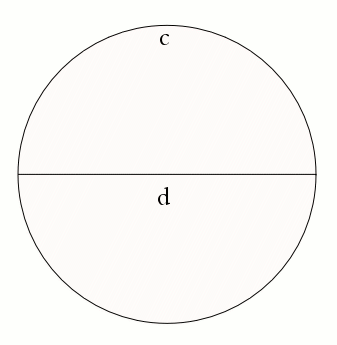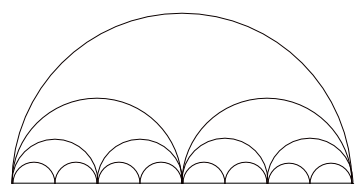
A proof with a hole: π equals 2
Forget all that business about
First of all, let's recall that

Now let's start with a circle of circumference 2, and only consider one half of it, as shown in the figure. Since it's exactly one half of the circle, the length of this semi-circle is 1. Now let's divide in half the diameter d of the circle, and draw a new, smaller semi-circle on each of the two halves. Since the ratio between diameter and circumference is the same for any circle, you can work out that the two smaller semi-circles — which are built on half the diameter of the larger one — have circumference half that of the larger one. In other words, the length of each of the two smaller semi-circles is 1/2.

Now continue in the same manner: divide the original diameter d into 4 equal pieces and draw on each of them a semi-circle of length 1/4; then divide it into 8 equal pieces and draw on each of them a semi-circle of length 1/8, etc, etc. After n steps you have 2n semi-circles, each of length 1/2n.

Obviously, the semi-circles get smaller and smaller at each stage, and after a great number of steps, your string of semi-circles will hardly be distinguishable from the straight line which forms the diameter of the largest circle. The string of semi-circles approximates the diameter d, and the approximation gets better and better the more steps you take. This means that the lengths of the semi-circles all added up approximate d. In fact, d is the limit of this sum as the number of steps n tends to infinity:
d = limn→∞ 2n×1/2n = 1.
We know that the circumference c of the large circle is 2, so
If you are stumped by last issue's puzzle, here is the solution.
For some challenging mathematical puzzles, see the NRICH puzzles from this month or last month.
Daz
I don't understand how in the second picture the length of the semicircle could be c/2 if the diameter is still d, as it is labeled.